
Billiard ball
Encyclopedia
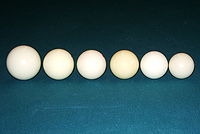
Ball
A ball is a round, usually spherical but sometimes ovoid, object with various uses. It is used in ball games, where the play of the game follows the state of the ball as it is hit, kicked or thrown by players. Balls can also be used for simpler activities, such as catch, marbles and juggling...
used in cue sports, such as carom billiards, pool, and snooker
Snooker
Snooker is a cue sport that is played on a green baize-covered table with pockets in each of the four corners and in the middle of each of the long side cushions. A regular table is . It is played using a cue and snooker balls: one white , 15 worth one point each, and six balls of different :...
. The number, type, diameter, color, and pattern of the balls differ depending upon the specific game being played. Various particular ball properties such as hardness, friction coefficient and resilience
Resilience
Resilience is the property of a material to absorb energy when it is deformed elastically and then, upon unloading to have this energy recovered. In other words, it is the maximum energy per unit volume that can be elastically stored...
are very important to the finer points of gameplay.
History
The earliest balls were made of wood and then later clay (the latter remaining in use well into the 20th century). Although affordable oxOx
An ox , also known as a bullock in Australia, New Zealand and India, is a bovine trained as a draft animal. Oxen are commonly castrated adult male cattle; castration makes the animals more tractable...
-bone balls were in common use in Europe, ivory
Ivory
Ivory is a term for dentine, which constitutes the bulk of the teeth and tusks of animals, when used as a material for art or manufacturing. Ivory has been important since ancient times for making a range of items, from ivory carvings to false teeth, fans, dominoes, joint tubes, piano keys and...
was favored since at least 1627 until the early 20th century; the earliest known written reference to ivory billiard balls is in the 1588 inventory of the Duke of Norfolk
Duke of Norfolk
The Duke of Norfolk is the premier duke in the peerage of England, and also, as Earl of Arundel, the premier earl. The Duke of Norfolk is, moreover, the Earl Marshal and hereditary Marshal of England. The seat of the Duke of Norfolk is Arundel Castle in Sussex, although the title refers to the...
. By the mid-19th century, elephants were being slaughtered for their ivory at an alarming rate, just to keep up with the demand for high-end billiard balls – no more than eight balls could be made from a single elephant's tusks. The billiard industry realized that the supply of elephants (their primary source of ivory) was endangered
Endangered species
An endangered species is a population of organisms which is at risk of becoming extinct because it is either few in numbers, or threatened by changing environmental or predation parameters...
, as well as dangerous to obtain (the latter an issue of notable public concern at the turn of the 19th century). Inventors were challenged to come up with an alternative material that could be manufactured
Manufacturing
Manufacturing is the use of machines, tools and labor to produce goods for use or sale. The term may refer to a range of human activity, from handicraft to high tech, but is most commonly applied to industrial production, in which raw materials are transformed into finished goods on a large scale...
, with a US$
United States dollar
The United States dollar , also referred to as the American dollar, is the official currency of the United States of America. It is divided into 100 smaller units called cents or pennies....
10,000 prize being offered by a New York supplier, Phelan and Collender
Brunswick Corporation
The Brunswick Corporation , formerly known as the Brunswick-Balke-Collender Company, is a United States-based corporation that has been involved in manufacturing a wide variety of products since 1845. Brunswick's global headquarters is in the northern Chicago suburb of Lake Forest, Illinois...
. (This would be worth $ today).
Although not the first artificial substance to be used for the balls (e.g. Sorel cement
Sorel cement
Sorel cement is a non-hydraulic cement first produced by Frenchman Stanislas Sorel in 1867.The cement is a mixture of magnesium oxide with magnesium chloride with the approximate chemical formula Mg4Cl268, corresponding to a weight ratio of 2.5–3.5 parts MgO to one part MgCl2...
, invented in 1867, was marketed as an artificial ivory), John Wesley Hyatt
John Wesley Hyatt
John Wesley Hyatt was an American inventor. He is mainly known for simplifying the production of celluloid, the first industrial plastic. Hyatt, a Perkin Medal recipient, is an inductee into the National Inventors Hall of Fame.-Biography:Hyatt was born in Starkey, New York, and began working as a...
invented a composition material in 1869 called nitrocellulose
Nitrocellulose
Nitrocellulose is a highly flammable compound formed by nitrating cellulose through exposure to nitric acid or another powerful nitrating agent. When used as a propellant or low-order explosive, it is also known as guncotton...
for billiard balls (US patent 50359, the first American patent for billiard balls). It is unclear if the cash prize was ever awarded, and there is no evidence suggesting he did in fact win it. By 1870 it was commercially branded Celluloid
Celluloid
Celluloid is the name of a class of compounds created from nitrocellulose and camphor, plus dyes and other agents. Generally regarded to be the first thermoplastic, it was first created as Parkesine in 1862 and as Xylonite in 1869, before being registered as Celluloid in 1870. Celluloid is...
, the first industrial plastic
Plastic
A plastic material is any of a wide range of synthetic or semi-synthetic organic solids used in the manufacture of industrial products. Plastics are typically polymers of high molecular mass, and may contain other substances to improve performance and/or reduce production costs...
. Unfortunately, the nature of celluloid made it volatile in production, occasionally exploding, which ultimately made this early plastic impractical. Urban legend
Urban legend
An urban legend, urban myth, urban tale, or contemporary legend, is a form of modern folklore consisting of stories that may or may not have been believed by their tellers to be true...
has it that celluloid billiard balls themselves would occasionally explode during rough play, but no reliable sources have been found that can substantiate this.
Subsequently, to avoid the problem of celluloid instability, the industry experimented with various other synthetic materials for billiards balls such as Bakelite, Crystalite and other plastic compounds.
The exacting requirements of the billiard ball are met today with balls cast from plastic materials that are strongly resistant to cracking and chipping. Currently Saluc
Saluc
Saluc S.A. is a Belgian speciality manufacturing company. Founded in 1923, they are best known for their Aramith brand billiard, pool and snooker balls...
, under the brand names Aramith and Brunswick Centennial, manufactures phenolic resin balls. Other plastics and resins such as polyester
Polyester
Polyester is a category of polymers which contain the ester functional group in their main chain. Although there are many polyesters, the term "polyester" as a specific material most commonly refers to polyethylene terephthalate...
(under various trade names) and clear acrylic
Acrylic glass
Poly is a transparent thermoplastic, often used as a light or shatter-resistant alternative to glass. It is sometimes called acrylic glass. Chemically, it is the synthetic polymer of methyl methacrylate...
are also used, by competing companies such as Elephant Balls Ltd. and Frenzy Sports.
Ivory balls remained in use in artistic billiards
Artistic billiards
Artistic billiards, sometimes called fantasy billiards or fantaisie classique, is a carom billiards discipline in which players compete at performing 76 preset shots of varying difficulty...
competition until the late 20th century.
- (See also Cue sports, "History" for more-general information on billiards history.)
Carom billiards
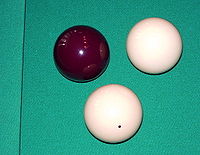
Balkline and straight rail
Balkline is the overarching title of a large array of carom billiards games generally played with two and a third, red , on a -covered, 5 foot × 10 foot, less table that is divided by on the cloth into marked regions called...
, and related games on pocketless billiards table
Billiards table
A billiard table or billiards table is a bounded table on which billiards-type games are played. In the modern era, all billiards tables provide a flat surface usually made of quarried slate, that is covered with cloth and surrounded by vulcanized rubber cushions, with the whole elevated above...
s, as well as English billiards
English billiards
English billiards, called simply billiards in many former British colonies and in Great Britain where it originated, is a hybrid form of carom and pocket billiards played on a billiard table. Billiards is less well known as "the English game", "the all-in game" and "the common game".The game is for...
which is played on a table with pockets. The predominantly-Asian game four-ball uses four balls (the name literally means "four-balls"). Carom balls are not numbered, and at 61–61.5 mm (between approximately and in) in diameter are larger than pool balls. The 61.5 mm size are more common. They are typically colored as follows:
- Red (or, uncommonly, blue; two object balls are used in some games)
- White for player 1
- White with a spot (or sometimes yellow) cue ball for player 2
International pool

Kelly pool
Kelly pool is a pocket billiards game played on a standard pool table using fifteen numbered markers called peas or pills, and a standard set of sixteen pool balls...
or American balls. These balls, used the most widely throughout the world, are considerably smaller than carom billiards balls, slightly larger than British-style pool balls and substantially larger than those for snooker. According to WPA
World Pool-Billiard Association
The World Pool-Billiard Association is the international governing body for pocket billiards . The group was formed in 1987, and was initially headed by a provisional board of directors consisting of representatives from Japan, the United States, Sweden, and Germany...
/BCA
Billiard Congress of America
Billiard Congress of America is a governing body for cue sports in North America , the regional member organization of the World Pool-Billiard Association...
equipment specifications, the weight may be from 5.5 to 6 oz. (156–170 g) with a diameter of 2.25 in. (57.15 mm), plus or minus 0.005 in. (0.127 mm). The balls are numbered and colored as follows:
- 1. Yellow
- 2. Blue
- 3. Red
- 4. Purple (pink in some ball sets)
- 5. Orange
- 6. Green
- 7. Brown or burgundy (tan in some ball sets)
- 8. Black
- 9. Yellow and white
- 10. Blue and white
- 11. Red and white
- 12. Purple and white (pink and white in some ball sets)
- 13. Orange and white
- 14. Green and white
- 15. Brown, or burgundy, and white (tan and white in some ball sets)
- , white (sometimes with one or more spots)
Note that balls 1 through 7 are often referred to as and 9 through 15 as though there are many other colloquial terms for each of balls (highs and lows, etc.). Though it looks similar to the solids, the 8 ball is not considered a solid. Some games such as nine-ball do not distinguish between stripes and solids, but rather use the numbering on the balls to determine which must be pocketed. In other games such as three-ball neither type of marking is of any consequence. In eight-ball, straight pool
Straight Pool
Straight pool, also called 14.1 continuous or simply 14.1, is a pocket billiards game, and was the common sport of championship competition until overtaken by faster-playing games like nine-ball...
, and related games, all sixteen balls are employed. In the games of seven-ball
Seven-ball
Seven-ball is a contemporary pool game with rules similar to nine-ball, though it differs in two key ways: the game uses only seven as implied by its name, and play is restricted to particular pockets of the table. William D. Clayton is credited with the game's invention, ca...
, nine-ball, ten-ball and related, only object balls 1 through 7, 9 and 10, respectively (plus the cue ball) are used.
Some balls used in televised pool games are colored differently to make them distinguishable on television monitors. Specifically, the 4 ball is colored pink instead of dark purple, and the 12 is white with a pink stripe, to make it easier to distinguish their color from the black 8 ball, and similarly the 7 and 15 balls use a light tan color instead of a deep brown. The TV is also the genesis of the "measle" cue ball with numerous spots on its surface so that placed on it is evident to viewers.
Coin-operated pool tables such as those found at bars
Bar (establishment)
A bar is a business establishment that serves alcoholic drinks — beer, wine, liquor, and cocktails — for consumption on the premises.Bars provide stools or chairs that are placed at tables or counters for their patrons. Some bars have entertainment on a stage, such as a live band, comedians, go-go...
historically have often used either a larger ("grapefruit") or denser ("rock", typically ceramic) cue ball, such that its extra weight makes it easy for the cue ball return mechanism to separate it from object balls (which are captured until the game ends and the table is paid again for another game) so that the cue ball can be returned for further play, should it be accidentally pocketed. Rarely in the US, some pool tables use a smaller cue ball instead. Modern tables usually employ a magnetic ball of regulation or near-regulation size and weight, since players have rightly complained for many decades that the heavy and often over-sized cue balls do not "play" correctly.
British-style pool (blackball)
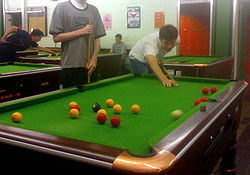
World Eight-ball Pool Federation
The World Eight-ball Pool Federation is an international pool governing body overseeing international tournaments and rankings...
or English-style eight-ball pool (not to be confused with the games of eight-ball or English billiards
English billiards
English billiards, called simply billiards in many former British colonies and in Great Britain where it originated, is a hybrid form of carom and pocket billiards played on a billiard table. Billiards is less well known as "the English game", "the all-in game" and "the common game".The game is for...
), fifteen object balls again are used, but fall into two unnumbered , the (or less commonly ) and , with a white cue ball, and black 8 ball. Aside from the 8, shots are not since there is no reliable way to identify particular balls to be pocketed. Because they are unnumbered they are wholly unsuited to certain pool games, such as nine-ball, in which ball order is important. They are noticeably smaller than the American-style balls, and with a cue ball that is slightly smaller than the object balls, while the table's are tighter to compensate. Neither the WPA nor the WEPF (publicly) define ball or even table dimensions, though presumably league and tournament organizers are given some guidelines in this regard. Most manufacturers that supply this market provide sets that range from 2 inch (5.08 cm) up to inch (56 mm), often with a slightly smaller cue ball, e.g. inches (4.76 cm) for a 2 inch set. The most common object ball diameters are 2 inch and inch (54 mm). The yellow-and-red sets are sometimes commercially referred to as "casino sets" (they were formerly used for televised eight-ball championships, most often held in casinos). The use of such sets, however, pre-dates television, as they were used for B.B.C. Co. Pool, the forerunner of modern eight-ball, at least as early as 1908.
Snooker
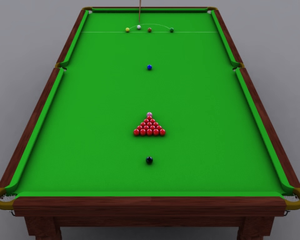
Snooker
Snooker is a cue sport that is played on a green baize-covered table with pockets in each of the four corners and in the middle of each of the long side cushions. A regular table is . It is played using a cue and snooker balls: one white , 15 worth one point each, and six balls of different :...
look at first glance like a mixture of American- and British-style pool balls. There are twenty-two balls in total, arranged as a rack of fifteen unmarked reds, six placed at various predetermined spots on the table, and a white cue ball. (See snooker
Snooker
Snooker is a cue sport that is played on a green baize-covered table with pockets in each of the four corners and in the middle of each of the long side cushions. A regular table is . It is played using a cue and snooker balls: one white , 15 worth one point each, and six balls of different :...
for more information on ball setup.)
The colour balls are sometimes numbered American-style, with their point values, for the amateur/home market, as follows:
- 2.
- 3.
- 4.
- 5.
- 6.
- 7.
Snooker balls are technically standardized at 52.5 mm (approximately in) in diameter within a tolerance of plus or minus 0.05 mm (0.002 in.) No standard weight is defined, but all balls in the set must be the same weight within a tolerance of 3 g. However, many sets are actually in. (a little under 52.4 mm), even from major manufacturers. Snooker sets are also available with considerably smaller-than-regulation balls (and even with ten instead of fifteen reds) for play on smaller tables (down to half-size), and are sanctioned for use in some amateur leagues. Sets for American snooker are typically in. (54 mm), with the numbered colour balls.
Other games
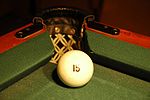
Kaisa (billiards)
Kaisa or karoliina is a cue sport mainly played in Finland. The game originated in Russia, where it is still played to some extent, and is a close cousin to Russian pyramid. Compared to most other billiards-type games, both use similar large 68 mm balls, small pockets barely large enough for...
has the same pocket and ball dimensions but it has only five balls: one yellow, two reds and two cue balls, one for each player. Bumper pool
Bumper pool
Bumper pool is a pocket billards game played on an octagonal or rectangular table fitted with an array of fixed cushioned obstacles, called bumpers, at the center of its surface.- Table :...
requires four white and four red object balls, and two special balls, one red with a white spot and the other the opposite; all are usually inch (approximately 52.5 mm) in diameter.
Training balls
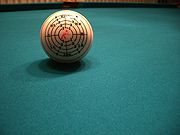
For example, Saluc markets several practice ball systems, including the Jim Rempe
Jim Rempe
James Rempe is an American professional pocket billiards player, and was inducted into the Billiard Congress of America's Hall of Fame in 2002.-Career:...
Training Ball, a marked with rings and targets on the surface of the ball so that the practicing player can better judge the effects of very particular amounts of , , and other forms of cue ball control, and learn better control of cue
Cue stick
A cue stick , is an item of sporting equipment essential to the games of pool, snooker and carom billiards. It is used to strike a ball, usually the...
. Various competing products, such as several other Saluc models and Elephant Practice Balls, use a similar aiming system. Some such sets consist of just a special cue ball and manual, while others contain both a cue ball and an object ball marked for aiming practice, along with the documenation.
Novelty balls
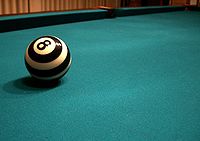
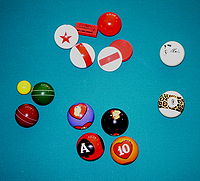
Entrepreneurial inventors also supply a variety of novelty billiard games with unique rules and balls, some with playing card markings, others with stars and stripes, and yet others in sets of more than thirty balls in several suits. Marbled-looking and glittery materials are also popular for home tables. There are even blacklight sets for playing in near-dark. There are also practical joke
Practical joke
A practical joke is a mischievous trick played on someone, typically causing the victim to experience embarrassment, indignity, or discomfort. Practical jokes differ from confidence tricks in that the victim finds out, or is let in on the joke, rather than being fooled into handing over money or...
cue and 8 balls, with off-center weights in them that make their paths curve and wobble. Miniature sets in various sizes (typically or of normal size) are also commonly available, primarily intended for under-sized toy tables. Even an egg-shaped ball has been patented and marketed under such names as Bobble Ball and Tag Ball.
In popular culture
The 8 ball is frequently used iconically in Western, especially American, culture. It can often be found as an element of T-shirt designs, album covers and names, tattoos, household goods like paperweights and cigarette lighters, belt buckles, etc. A classic toy is the Magic 8-BallMagic 8-ball
The Magic 8 Ball is a toy used for fortune-telling or seeking advice, manufactured by Mattel.-Origin:While Magic 8-Ball did not exist in its current form until 1950, the functional component was invented by Albert C. Carter, who was inspired by a "spirit writing" device used by his mother, Mary, a...
"oracle". A wrestler, a rapper, and a rock band have all independently adopted the name. The term "8 ball" is also slang
Slang
Slang is the use of informal words and expressions that are not considered standard in the speaker's language or dialect but are considered more acceptable when used socially. Slang is often to be found in areas of the lexicon that refer to things considered taboo...
both for oz.
Ounce
The ounce is a unit of mass with several definitions, the most commonly used of which are equal to approximately 28 grams. The ounce is used in a number of different systems, including various systems of mass that form part of the imperial and United States customary systems...
of cocaine
Cocaine
Cocaine is a crystalline tropane alkaloid that is obtained from the leaves of the coca plant. The name comes from "coca" in addition to the alkaloid suffix -ine, forming cocaine. It is a stimulant of the central nervous system, an appetite suppressant, and a topical anesthetic...
or crystal meth, and for a bottle of Olde English 800 malt liquor
Malt liquor
Malt liquor is a North American term referring to a type of beer with high alcohol content. In legal statutes, the term often includes any alcoholic beverage above or equal to 5% alcohol by volume made with malted barley. In common parlance, however, it is used for high-alcohol beers made with...
. It has also been used to refer to African-Americans, particularly those of darker skin tones, as in the film Full Metal Jacket
Full Metal Jacket
Full Metal Jacket is a 1987 war film produced and directed by Stanley Kubrick. It is an adaptation of the 1979 novel The Short-Timers by Gustav Hasford and stars Matthew Modine, Vincent D'Onofrio, R. Lee Ermey, Arliss Howard and Adam Baldwin. The film follows a platoon of U.S...
. The expression "behind the eight (ball)" is used throughout the English
English language
English is a West Germanic language that arose in the Anglo-Saxon kingdoms of England and spread into what was to become south-east Scotland under the influence of the Anglian medieval kingdom of Northumbria...
-speaking world to indicate a dilemma
Dilemma
A dilemma |proposition]]") is a problem offering two possibilities, neither of which is practically acceptable. One in this position has been traditionally described as "being on the horns of a dilemma", neither horn being comfortable...
from which it is difficult to extricate oneself. The term derives from the game kelly pool
Kelly pool
Kelly pool is a pocket billiards game played on a standard pool table using fifteen numbered markers called peas or pills, and a standard set of sixteen pool balls...
.
Because the collisions between billiard balls are nearly elastic
Elastic collision
An elastic collision is an encounter between two bodies in which the total kinetic energy of the two bodies after the encounter is equal to their total kinetic energy before the encounter...
, and the balls roll on a surface that produces low rolling friction, their behavior is often used to illustrate Newton's laws of motion
Newton's laws of motion
Newton's laws of motion are three physical laws that form the basis for classical mechanics. They describe the relationship between the forces acting on a body and its motion due to those forces...
. Idealized, frictionless billiard balls are a staple of mathematical
Mathematics
Mathematics is the study of quantity, space, structure, and change. Mathematicians seek out patterns and formulate new conjectures. Mathematicians resolve the truth or falsity of conjectures by mathematical proofs, which are arguments sufficient to convince other mathematicians of their validity...
theorems and physics
Physics
Physics is a natural science that involves the study of matter and its motion through spacetime, along with related concepts such as energy and force. More broadly, it is the general analysis of nature, conducted in order to understand how the universe behaves.Physics is one of the oldest academic...
models, and figure in dynamical billiards
Dynamical billiards
A billiard is a dynamical system in which a particle alternates between motion in a straight line and specular reflections from a boundary. When the particle hits the boundary it reflects from it without loss of speed...
, scattering theory
Scattering theory
In mathematics and physics, scattering theory is a framework for studying and understanding the scattering of waves and particles. Prosaically, wave scattering corresponds to the collision and scattering of a wave with some material object, for instance sunlight scattered by rain drops to form a...
, Lissajous knots, billiard ball computing and reversible cellular automata
Reversible cellular automaton
A reversible cellular automaton is a cellular automaton in which every configuration has a unique predecessor. Several methods of constructing reversible cellular automata are known, including the block cellular automaton and second-order cellular automaton methods...
, Polchinski's paradox, contact dynamics
Contact dynamics
Contact dynamics deals with the motion of multibody systems subjected to unilateral contacts and friction. Such systems are omnipresent in many multibody dynamics applications...
, collision detection
Collision detection
Collision detection typically refers to the computational problem of detecting the intersection of two or more objects. While the topic is most often associated with its use in video games and other physical simulations, it also has applications in robotics...
, the illumination problem
Illumination problem
The illumination problem is a resolved mathematical problem first posed by Ernst Straus in the 1950s. Straus asked if a room with mirrored walls can always be illuminated by a single point light source, allowing for repeated reflection of light off the mirrored walls...
, atomic ultracooling
Ultracold atom
Ultracold atoms is a term used to describe atoms that are maintained at temperatures close to 0 kelvins , typically below some tenths of microkelvins , where their quantum-mechanical properties become important...
, quantum mirage
Quantum mirage
In physics, a quantum mirage is a peculiar result in quantum chaos. Every system of quantum dynamical billiards will exhibit an effect called scarring, where the quantum probability density shows traces of the paths a classical billiard ball would take...
s and elsewhere in these fields.
"Billiard balls" or "pool balls" is the name given to balls used in stage magic tricks, especially the classic "multiplying billiard balls
Multiplying billiard balls
Multiplying billiard balls is a magic routine that is popular with both amateur and advanced conjurors but still rarely seen...
". Though obviously derived from real billiard balls, today they are usually smaller, for easier manipulation and hiding, but not so small and light that they are difficult to juggle, as the magic and juggling disciplines have often overlapped since their successful combination by pioneers like Paul Vandy
Paul Vandy
Paul Vandy born Charles Edward Maynard, known as the juggling magician, was a prolific performer from around 1894 to 1930 and is credited as the originator of magical juggling....
.
The phrase "as smooth as a billiard ball" is sometimes applied to describe a bald person
Baldness
Baldness implies partial or complete lack of hair and can be understood as part of the wider topic of "hair thinning". The degree and pattern of baldness can vary greatly, but its most common cause is male and female pattern baldness, also known as androgenic alopecia, alopecia androgenetica or...
, and the term "cue ball" is also slang
Slang
Slang is the use of informal words and expressions that are not considered standard in the speaker's language or dialect but are considered more acceptable when used socially. Slang is often to be found in areas of the lexicon that refer to things considered taboo...
for someone who sports a shaved head.

